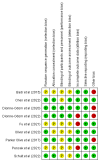Effects of Telemedicine on Informal Caregivers of Patients in Palliative Care: Systematic Review and Meta-Analysis
- PMID: 38602303
- PMCID: PMC11024400
- DOI: 10.2196/54244
Effects of Telemedicine on Informal Caregivers of Patients in Palliative Care: Systematic Review and Meta-Analysis
Abstract
Background: Telemedicine technology is a rapidly developing field that shows immense potential for improving medical services. In palliative care, informal caregivers assume the primary responsibility in patient care and often face challenges such as increased physical and mental stress and declining health. In such cases, telemedicine interventions can provide support and improve their health outcomes. However, research findings regarding the use of telemedicine among informal caregivers are controversial, and the efficacy of telemedicine remains unclear.
Objective: This study aimed to evaluate the impacts of telemedicine on the burden, anxiety, depression, and quality of life of informal caregivers of patients in palliative care.
Methods: A systematic literature search was conducted using the PubMed, Embase, Web of Science, CENTRAL, PsycINFO, CINAHL Plus with Full Text, CBM, CNKI, WanFang, and VIP databases to identify relevant randomized controlled trials published from inception to March 2023. Two authors independently screened the studies and extracted the relevant information. The methodological quality of the included studies was assessed using the Cochrane risk-of-bias tool. Intervention effects were estimated and sensitivity analysis was conducted using Review Manager 5.4, whereas 95% prediction intervals (PIs) were calculated using R (version 4.3.2) and RStudio.
Results: A total of 9 randomized controlled trials were included in this study. The meta-analysis indicated that telemedicine has reduced the caregiving burden (standardized mean differences [SMD] -0.49, 95% CI -0.72 to -0.27; P<.001; 95% PI -0.86 to -0.13) and anxiety (SMD -0.23, 95% CI -0.40 to -0.06; P=.009; 95% PI -0.98 to 0.39) of informal caregivers; however, it did not affect depression (SMD -0.21, 95% CI -0.47 to 0.05; P=.11; 95% PI -0.94 to 0.51) or quality of life (SMD 0.35, 95% CI -0.20 to 0.89; P=.21; 95% PI -2.15 to 2.85).
Conclusions: Although telemedicine can alleviate the caregiving burden and anxiety of informal caregivers, it does not significantly reduce depression or improve their quality of life. Further high-quality, large-sample studies are needed to validate the effects of telemedicine. Furthermore, personalized intervention programs based on theoretical foundations are required to support caregivers.
Keywords: PRISMA; Preferred Reporting Items for Systematic Reviews and Meta-Analyses; anxiety; caregiver burden; depression; informal caregivers; meta-analysis; palliative care; quality of life; systematic review; telemedicine.
© Xiaoyu Yang, Xueting Li, Shanshan Jiang, Xinying Yu. Originally published in JMIR mHealth and uHealth (https://mhealth.jmir.org).
Conflict of interest statement
Figures




Similar articles
-
The effect of targeted palliative care interventions on depression, quality of life and caregiver burden in informal caregivers of advanced cancer patients: A systematic review and meta-analysis of randomized controlled trials.Int J Nurs Stud. 2024 Dec;160:104895. doi: 10.1016/j.ijnurstu.2024.104895. Epub 2024 Sep 6. Int J Nurs Stud. 2024. PMID: 39305684
-
The effectiveness of e-Health interventions on caregiver burden, depression, and quality of life in informal caregivers of patients with cancer: A systematic review and meta-analysis of randomized controlled trials.Int J Nurs Stud. 2022 Mar;127:104179. doi: 10.1016/j.ijnurstu.2022.104179. Epub 2022 Jan 17. Int J Nurs Stud. 2022. PMID: 35124473
-
E-Health interventions for anxiety and depression in children and adolescents with long-term physical conditions.Cochrane Database Syst Rev. 2018 Aug 15;8(8):CD012489. doi: 10.1002/14651858.CD012489.pub2. Cochrane Database Syst Rev. 2018. PMID: 30110718 Free PMC article.
-
Exercise programs for people with dementia.Cochrane Database Syst Rev. 2015 Apr 15;2015(4):CD006489. doi: 10.1002/14651858.CD006489.pub4. Cochrane Database Syst Rev. 2015. PMID: 25874613 Free PMC article.
-
Educational interventions for the management of cancer-related fatigue in adults.Cochrane Database Syst Rev. 2016 Nov 24;11(11):CD008144. doi: 10.1002/14651858.CD008144.pub2. Cochrane Database Syst Rev. 2016. PMID: 27883365 Free PMC article.
Cited by
-
Factors that influence the preferences for telehealth among family caregivers of disabled elders: a qualitative study.Int J Nurs Stud Adv. 2025 May 21;8:100351. doi: 10.1016/j.ijnsa.2025.100351. eCollection 2025 Jun. Int J Nurs Stud Adv. 2025. PMID: 40510461 Free PMC article.
-
[Analysis of skills and perceptions regarding mHealth in the management of chronic patients by primary care professionals].Aten Primaria. 2025 Feb;57(2):103142. doi: 10.1016/j.aprim.2024.103142. Epub 2024 Nov 18. Aten Primaria. 2025. PMID: 39561676 Free PMC article. Spanish.
-
Telemedicine for educating parents or caregivers for postoperative care of pediatric patients: a systematic review.Front Public Health. 2025 Jul 30;13:1606211. doi: 10.3389/fpubh.2025.1606211. eCollection 2025. Front Public Health. 2025. PMID: 40809776 Free PMC article.
References
-
- Gomes B, Calanzani N, Curiale V, McCrone P, Higginson IJ. Effectiveness and cost-effectiveness of home palliative care services for adults with advanced illness and their caregivers. Cochrane Database Syst Rev. 2013 Jun 6;2013(6):CD007760. doi: 10.1002/14651858.CD007760.pub2. doi. Medline. - DOI - PMC - PubMed
Publication types
MeSH terms
LinkOut - more resources
Full Text Sources
Medical
Research Materials
Miscellaneous

